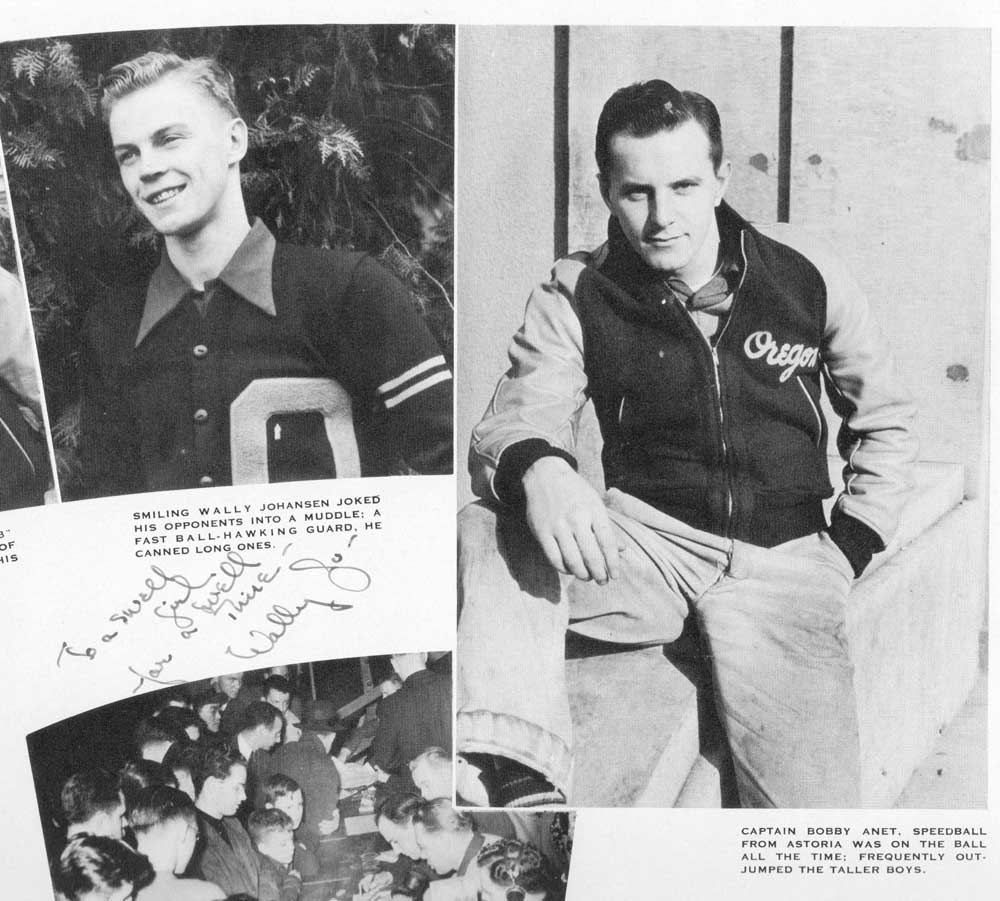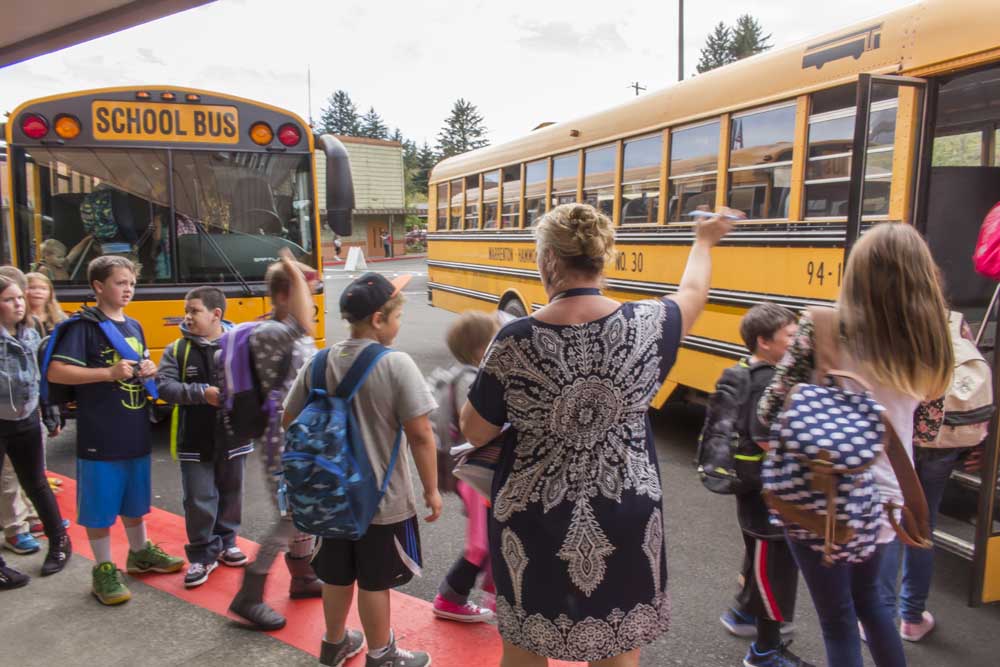Oregon’s storied ‘Tall Firs’ grew in Astoria
Published 4:29 pm Thursday, March 30, 2017

- Astoria's Wally Johansen, left, and Bobby Anet were featured in the 1939 edition of ‘Oregana,' the yearbook for the University of Oregon.
The Oregon Ducks will be playing in their first Final Four in 78 years.
The Ducks will take on North Carolina in one semifinal Saturday, while Gonzaga and South Carolina square off in the other half of the bracket. And no doubt we will hear — more than once — this weekend about the “Tall Firs,” Oregon’s national championship team of 1939.
What you likely won’t hear, though, is that five of the Webfoots were from Astoria.
So — for us locals, anyway — when announcers start talking about the Tall Firs, Astorians can go ahead and claim a little credit for the first national championship ever won.
Basketball has certainly changed over the past 78 years, and so, too, has recruiting.
The roster for the 1938-39 Oregon men’s basketball team included players from towns in Oregon and Washington state, and one reserve from Vancouver, British Columbia. And that was it.
No Californians, no Texans, no Floridians … no one from outside the upper corner of the Pacific Northwest.
Fast-forward 78 years, and take a look at Oregon’s roster: Players from Montreal, Quebec; Brampton and Mississauga, Ontario; London, England; Ashdod, Israel … big city players from Chicago and Seattle; Sacramento, Irvine, Long Beach, Los Angeles and Santa Ana, California; Tempe, Arizona; and the lone player from Oregon, freshman Payton Pritchard of West Linn.
Quite the difference from 1938-39, when — other than a couple of Portlanders — the Webfoots sported players from smaller towns like The Dalles, Ashland, Oakridge, Longview and Raymond, Washington … and five from Astoria.
The Pac-12 had four teams in this year’s field of 64 (and three in the Sweet 16). If you listened to players on that 1938-39 Oregon squad, not much has changed.
Almost to a man, the players for the 1939 national championship team from Oregon agreed that the balance of power in college basketball was in the Pacific Coast Conference (later the Pac-8, Pac-10 and currently the Pac-12).
Lauren “Laddie” Gale, from Oakridge, was one of three All-Americans who played for the 1938-39 Webfoots.
In a 1995 interview, Gale said, “We felt afterwards, talking it over, that the Pacific Coast teams were superior to the rest of the country. The teams we played in the playoffs — Texas and Oklahoma — weren’t as good; and Ohio State, the team we played (and beat, 46-33) in the final, wasn’t very strong at all.
“We never felt threatened” in the final against the Buckeyes, Gale said. “Our biggest competition was within our own conference. The Eastern teams were still using the two-handed set shot. They hadn’t adopted the one-handed shot yet. They were calling those ‘hope shots.’”
Oregon coach Howard Hobson’s team averaged fewer than 50 points a game in 1938-39, but they featured three All-Americans — Gale, Urgel “Slim” Wintermute of Longview, Washington, and Bobby Anet, from Astoria.
Hobson brought ’em all together and made them winners.
“Hobby was one of the best,” said Gale, who — along with Hobson — were the first two Webfoots enshrined in the Basketball Hall of Fame. Hobson died in 1991, Gale passed away in 1996.
“In those years,” Gale said in 1995, Hobson “was way ahead of the rest of the coaches. We had a lot of fire-power, as far as the guards were concerned.”
Those guards were seniors Anet and Wally Johansen, lifelong teammates and childhood buddies from Astoria.
“They had played all the way through junior high, and they went through Astoria High School together,” Gale said. “We were a fast-break team.”
Anet and Johansen had both won state titles at Astoria before heading to the University of Oregon, along with high school teammates Earl Sandness and Ted Sarpola, a sophomore and junior, with the 1938-39 Oregon team.
Johansen was later a sports editor at the Evening Astoria-Budget and died of a heart attack in 1971 while on a fishing trip with his family on the Rogue River; Anet lived in Lake Oswego and died in 1980.
After serving in the Korean War, Sandness was a teacher and coach in Anchorage, Alaska, taught and coached in Portland until 1979, then moved to Ilwaco, Washington, where he owned and operated a tourist charter boat. He died of cancer in 1984.
Sarpola served in the U.S. Coast Guard, and from 1965 to 1981, taught various subjects at schools, including Knappa High School. He died in 1985.
The late Toivo Piippo was the fifth Astoria High graduate on the 1938-39 Oregon team, but by the time of the national championship game, Piippo had suffered a season-ending leg injury.
Piippo piloted B-26 bombers in World War II, and was later awarded a Distinguished Flying Cross. He taught and coached in Marysville and Richland, Washington, and died in 2003.
Just how did all those Astoria players end up at Oregon?
That story was told by Wally Palmberg, an Astoria High School grad who played for the Fishermen (and later Oregon State).
In a 2001 interview, Palmberg said Hobson wanted the Astorians “real badly. So the Oregon people approached John Warren (then a coach at Astoria High School), and told him, ‘if you bring all those Astoria kids to Oregon, we’ll hire you as freshman coach.
“And it worked. The whole party, en masse, went to Oregon, and it paid off for ’em. Five years later, they won the national title with those kids.”
Warren later coached varsity basketball and football at Oregon.
John Dick of The Dalles was one of the last surviving members of the Tall Firs, until his death in 2011 at age 92.
He remembers “the road to the Final Four” in 1939 being a lot different than today’s heavily-commercialized version.
In the 1939 postseason, the Webfoots first had to play a best two-of-three series with California at Mac Court. It was scheduled for a Thursday, Friday and Saturday, with the winner advancing to the Western Regionals the following Monday in San Francisco.
In a 1996 interview, Dick said, “we figured we’d better win those first two games if we wanted to get any rest. So we did manage to beat Cal in two games on Thursday and Friday, we spent the night (in Eugene), and we got to San Francisco Sunday afternoon.”
In the Western Regionals, Oregon defeated Texas and Oklahoma in two days, then boarded a train for Chicago. Once they arrived in Evanston, Illinois — site of the national championship — the Webfoots ran all over Ohio State in the title game.
“We ended up playing five games in 10 or 11 days, plus we traveled all that distance just to get there,” Dick said. “Ohio State had a whole week to prepare for us, and we were playing on a Big 10 court with Big 10 officials.”
He agreed with Gale, in that “we were clearly the superior conference. Nobody could challenge the PCC. The toughest games we had were always against Washington and California. The West Coast was clearly ahead of the rest of the country.”
For Dick and the rest of the “Tall Firs” — as they were referred to in a column by the Oregonian’s L.H. Gregory on March 3, 1938 — the celebration after the national championship win was just beginning.
The city of The Dalles heard that the team’s train would be passing through town, and the tracks were practically barricaded to get the Union Pacific engineer to stop for a celebration.
“After we had won the championship, that created a lot of excitement in Oregon,” Dick said. “We got to The Dalles at 5:30 in the morning, and The Dalles, which had about 5,000 or 6,000 people then, roughly half that showed up at the train station.”
City officials presented Dick with a Hamilton watch (“the Rolex of its day,” he said), and the celebration lasted over 10 minutes.
“When word got out what The Dalles had done for me, all the other hometowns with players on the team had to come up with gold watches for their players,” Dick said. “It was the toughest for Astoria, which had four guys on the team, so they had to come up with four watches.”





